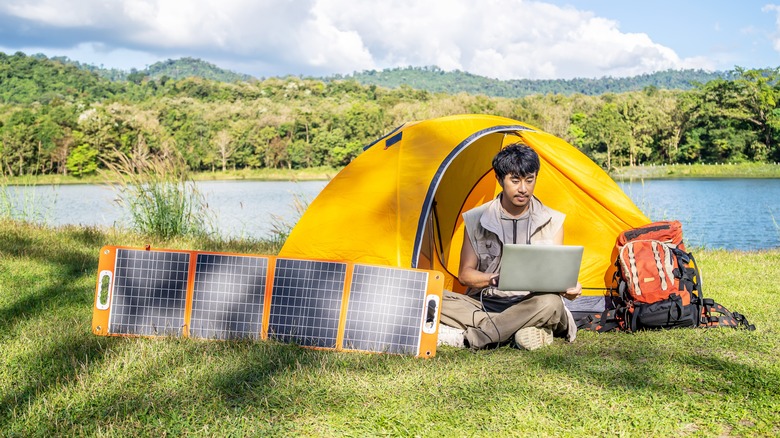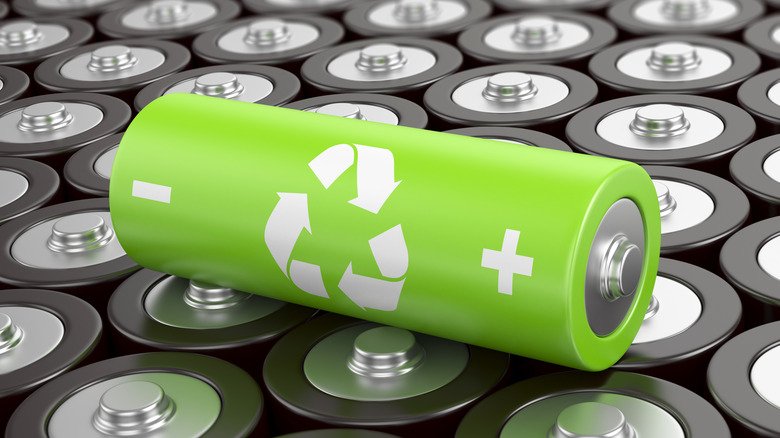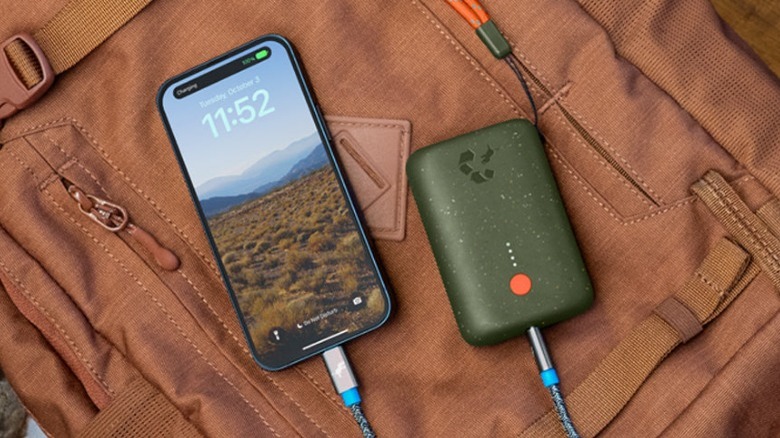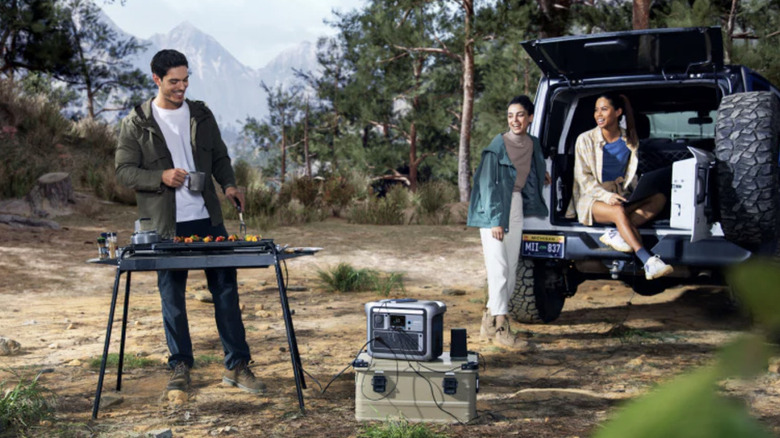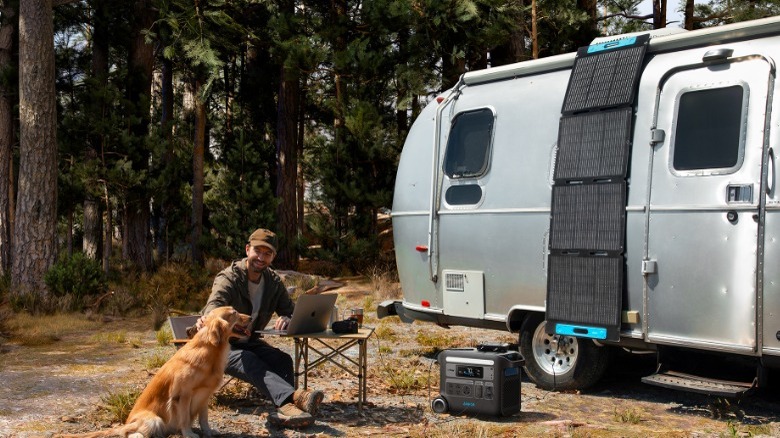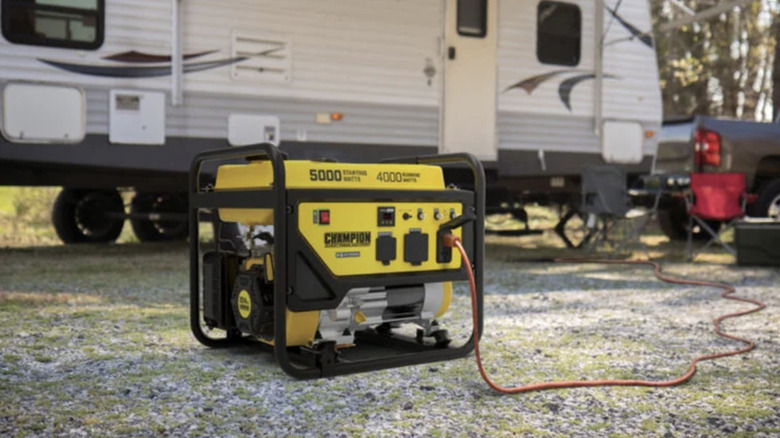5 Ways To Power Your Campsite With Electricity
We may receive a commission on purchases made from links.
Getting back to nature can be a revitalizing experience. Sometimes it's nice to spend some time in the great outdoors with nothing between you and the open sky. While some campers might prefer to get as far away from technology as possible, others may not want to completely leave the 21st century behind them. Even from a strictly utilitarian point of view, lights, radios, and power inflators all need electricity to operate.
It's also nice to have a fully charged phone even if you don't want to be staring at a screen the entire time, just in case you need to use it in the event of an emergency. A lot of campsites don't come with a power outlet anywhere nearby, though, and daisy-chaining a few miles of extension cord isn't exactly a practical solution. So, those of you who want to have electricity at the site will have to bring your own.
There are a few different ways that you can do this. Batteries, power banks, power stations, solar panels, and generators are all viable solutions. There are pros and cons to each of these options, though. You might want to learn a bit more about what each of them are and how they work before choosing which option you're going to take with you on your journey into the wilderness.
Batteries: Cheap and practical power
Batteries are the cheapest solution for powering the electrical devices in your campsite. A lot of modern tech has moved toward integrating rechargeable lithium-ion batteries into the product itself, but there is still plenty of camping gear out there that's powered by AAA, AA, C, D, and 9V batteries. There are rechargeable versions of all of these as well. Amazon Basics makes ones that are quite affordable, so you don't necessarily need to stick to disposable alkaline cells, but either of these options will work so long as you have an ample supply of replacements. They're also lightweight and easy to carry in a backpack or stash with your other equipment, which is always convenient when camping.
Those aren't the only types of batteries out there, though. There are also several power tool brands that make battery-powered camping equipment. Ryobi, Milwaukee, Makita, DeWalt, and several other brands make lights, radios, and other camping equipment that are designed to run on their proprietary rechargeable power tool batteries. This is certainly an advantageous solution for power tool users who have already invested in these battery systems. It's also worth noting that these batteries tend to be more powerful and offer larger storage capacity than most disposable (or rechargeable replacement) batteries. This means that they can make tools and appliances run longer and more effectively.
Power banks: Keep your devices charged
Another option is to bring a power bank. These are essentially larger rechargeable batteries that are designed to charge other battery-operated devices rather than replace the battery inside of them. These are great for smartphones, tablets, e-readers, handheld gaming consoles, and other small devices with internal batteries. There are a ton of great power bank options to choose from for your next camping trip. Most of them connect to your device via a USB-A or USB-C port. This allows you to pair the bank with whatever kind of cable you need to charge your various devices. Some, like the Ugreen Magnetic Battery Mini, are even able to wirelessly charge your devices.
The capacity of a power bank is typically measured in milliampere hours (mAh). You can get a lot of small, portable power banks that are rated in the 2,000-5,000 mAh range and are designed to charge a single mobile device for pretty cheap. These are handy to have, but they can run out of juice quickly, so you might not want to rely on them as a power source for an entire camp. Anker, Baseus, Einova, Otterbox, and Belkin are all great brands if you're looking to purchase one.
Then there are larger options, like the Nuxgal Power Portable Charger Power Bank, which has a 60,000 mAh capacity and can be reliably used to keep several devices fully charged over a long period. Even these high-capacity power banks aren't typically powerful enough to run an AC connection, however, so you will probably need an alternative solution for anything that requires a higher output.
Power stations: Bigger batteries for more power
The next step-up would be to take a look at some of the power stations that are out there. These are similar to power banks in that they are also essentially large batteries that are used to charge other devices, but there are a few distinctions that separate them. Power stations are sort of like a stop-gap between a power bank and a generator. They tend to be much larger than power banks and often have the same USB outputs, but they also offer other outlets that are able to supply a significantly higher current, such as AC connections. This means that you should be able to plug in some devices that require an outside energy source and power them directly from the power station.
These also come in all different sizes and are priced accordingly. One of the smaller options from Anker, for instance, is an 87-watt model that has a built-in light and a digital display that you can get for $140 on Amazon. Then there's the middleweight options like the Anker Powerhouse 200 that balances power and lightweight portability or the Anker 757 Powerhouse. Then there are even larger capacity chargers from other brands like the Jackery Explorer 3000 Pro and the EcoFlow Delta Pro. So clearly there's a pretty wide range of options.
You can also find super affordable options in the midrange like the PGYOB 200W Station. Similarly, Bluetti makes a 200W model and a 750W model that are flexable powerful, and easy to use. Taking a look at SlashGear's hands-on reviews like the ones above or a quick search is all it takes to find dozens of power stations available from different companies with varying capacities and features. It's also worth noting that there are several power stations that are made by power tool companies like Ryobi. These work just like regular power stations, but they can also charge the batteries that you need for other products made by the company.
Solar panels: Renewable energy anywhere
What better way to provide electricity for your campsite than to harness the power of the sun? Solar panels have grown much more affordable in recent years, and portable units are a great way to provide free, renewable energy for your campsite — though it still takes a while for them to pay for themselves.
There are some misconceptions out there about solar panels, however. The panels capture energy, but they don't store it themselves. To do that, the panels need to be connected to a battery of some sort. BigBlue sells a 28W foldable solar panel that has a built-in 4A battery, which essentially works like a small renewable power bank. Most larger panels, like Thunderbolt Solar Panels or this Doroeo 100W foldable panel, don't come with a battery built-in. These are designed to be paired with a compatible power station so you can continue to gather power and replenish used electricity over the course of your camping trip, prolonging the life of the station and ensuring that you can use it for longer. The larger the wattage of the solar panel, the more energy it will be able to capture.
Some companies, like Marbero and EcoFlow, sell kits that pair compatible solar panels and power stations so you can get everything you need at once. Of course, you can always just buy a power station now and then wait to get a compatible solar panel later if you find it isn't lasting as long as you want it to.
Generators: Powerful gas-fueled energy
Solar panels, power stations, and batteries are all great ways to keep a few small devices powered during a camping trip, but nothing beats a generator when it comes to raw power output. There are a lot of major brands that sell generators. They come in a variety of sizes and power outputs, but there are also a couple of different types of generators out there: traditional gas generators and inverter generators.
Traditional generators use a gas-powered engine and an alternator to generate electricity. This allows you to plug your devices directly into the generator's control panel and draw the energy as it's produced. Inverter generators do this too, but they take the extra step to convert AC electricity to DC and then back to AC. This might not seem important, but it makes the generators significantly quieter, allows them to run on less fuel, and gives them a steadier output of electricity that is safer for the tools and appliances being plugged into it.
You probably won't want to trek a massive generator that's designed to power a house out into the woods. There are, however, plenty of small, portable generators that you can find for prices comparable to power stations that are able to produce even more electricity. Champion and Ryobi both make 4000W Inverter generators that would make great midsized options for any campsite. You'll just need to remember to bring gas as well.
